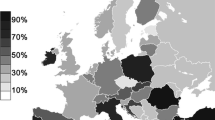Abstract
As medical technology continues increasing the possibility of living a longer life, the public’s valuing of these developments must be considered. This study examines attitudes toward extending the human life span within a student population at a Christian university. Religious factors were hypothesized to affect life extension desirability. Scores on measures of willingness to defer to God’s will, meaning derived from religion, positive afterlife beliefs, and intrinsic religiosity were significantly and inversely related to life extension desirability. Implications of these findings are discussed, including encouraging medical practitioners to respect decision-making processes of religious persons who may find life extension interventions undesirable.
Similar content being viewed by others

References
Allport, G. W., & Ross, J. M. (1967). Personal religious orientation and prejudice. Journal of Personality and Social Psychology, 5, 432–443.
Azusa Pacific University. (2012). Total student enrollment [Data file]. Retrieved from http://www.apu.edu/live_data/files/194/12_total_student_enrollment.pdf.
Barnato, A. E., Anthony, D. L., Skinner, J., Gallagher, P. M., & Fisher, E. S. (2009). Racial and ethnic differences in preferences for end-of-life treatment. Journal of General Internal Medicine, 24, 695–701.
Bortolotti, L. (2010). Agency, life extension, and the meaning of life. The Monist, 93(1), 38–56.
Brett, A. S., & Jersild, P. (2003). “Inappropriate” treatment near end of life. Archives of Internal Medicine, 163(14), 1645–1649.
Cicirelli, V. G. (2011a). Religious and nonreligious spirituality in relation to death acceptance or rejection. Death Studies, 35, 124–146.
Cicirelli, V. G. (2011b). Elders’ attitudes toward extending the healthy life span. Journal of Aging Studies, 25, 84–93.
Cohen, A. B., Pierce, J. D, Jr, Chambers, J., Meade, R., Gorvine, B., & Koenig, H. G. (2005). Intrinsic and extrinsic religiosity, belief in the afterlife, death anxiety, and life satisfaction in young Catholics and Protestants. Journal of Research in Personality, 39, 307–324.
De Grey, A. (2004). Escape velocity. PLoS Biology, 2(6), 723–726.
Dechesne, M., Pyszczynski, T., Arndt, J., Ransom, S., Sheldon, K. M., Knippenberg, A., & Janssen, J. (2003). Literal and symbolic immortality: The effect of evidence of literal immortality on self-esteem striving in response to mortality salience. Journal of Personality and Social Psychology, 84, 723–737.
Dezutter, J., Soenens, B., Luyckx, K., Bruyneel, S., Vansteenkiste, M., Duriez, B., & Hutsebaut, D. (2009). The role of religion in death attitudes: Distinguishing between religious belief and style of processing religious contents. Death Studies, 33(1), 73–92.
Dragojlovic, N. (2013). Canadians’ support for radical life extension resulting from advances in regenerative medicine. Journal of Aging Studies, 27(2), 151–158.
Ejaz, F. K. (2000). The influence of religious and personal values on nursing home residents’ attitudes toward life-sustaining treatments. Social Work in Health Care, 32(2), 23–39.
Florian, V., & Mikulincer, M. (1998). Symbolic immortality and the management of the terror of death: The moderating role of attachment style. Journal of Personality and Social Psychology, 74, 725–734.
Gorsuch, R. L., & McPherson, S. E. (1989). Intrinsic/extrinsic measurement: I/E-revised and single-item scales. Journal for the Scientific Study of Religion, 28(2), 348–354.
Gorsuch, R. L., Mylvaganam, G., & Gorsuch, K. (1997). Perceived religious motivation. International Journal for the Psychology of Religion, 7(4), 253–261.
Karel, M. J., & Gatz, M. (1996). Factors influencing life-sustaining treatment decisions in a community sample of families. Psychology and Aging, 11(2), 226–234.
Lang, F. R., Baltes, P. B., & Wagner, G. G. (2007). Desired lifetime and end-of-life desires across adulthood from 20 to 90: A dual-source information model. Journal of Gerontology, 62(5), 268–276.
Lucke, J. C., Herbert, D., Partridge, B., & Hall, W. D. (2010). Anticipating the use of life extension technologies: Possible pointers from the adoption of assisted reproductive technologies. EMBO Reports, 11(5), 334–338.
Lyon, K. B. (2004). Faith and development in late adulthood. In F. B. Kelcourse (Ed.), Human development and faith: Life-cycle stages of body, mind, and soul (pp. 269–284). St. Louis, MO: Chalice.
Moody, H. R. (2002). Who’s afraid of life extension? Generations, 25(4), 33–37.
Orr, R. B., & Genesen, L. B. (1997). Requests for “inappropriate” treatment based on religious beliefs. Journal of Medical Ethics, 23, 142–147.
Partridge, B., Lucke, J., Bartlett, H., & Hall, W. (2009a). Ethical, social, and personal implications of extended human lifespan identified by members of the public. Rejuvenation Research, 12(5), 351–357.
Partridge, B., Lucke, J., Bartlett, H., & Hall, W. (2011). Public attitudes towards human life extension by intervening in ageing. Journal of Aging Studies, 25, 73–83.
Partridge, B., Lucke, J., & Hall, W. (2010). Listening to public concerns about human life extension. EMBO Reports, 11, 735–737.
Partridge, B., Underwood, M., Lucke, J., Bartlett, H., & Hall, W. (2009b). Ethical concerns in the community about technologies to extend human life span. The American Journal of Bioethics, 9(12), 68–76.
Pugh, E. J., Song, R., Whittaker, V., & Blenkinsopp, J. (2009). A profile of the belief system and attitudes to end-of-life decisions of senior clinicians working in a national health service hospital in the United Kingdom. Palliative Medicine, 23, 158–164.
Shrestha, L. B. (2006). Life expectancy in the United States. CRS Report RL32792, US Congressional Research Service.
Turner, L. (2004). Life extension research: Health, illness, and death. Health Care Analysis, 12(2), 117–129.
Underwood, M., Bartlett, H. P., Partridge, B., Lucke, J., & Hall, W. D. (2009). Community perceptions on the significant extension of life: An exploratory study among urban adults in Brisbane, Australia. Social Science and Medicine, 68, 496–503.
Winter, L., Dennis, M. P., & Parker, B. (2009). Preferences for life-prolonging medical treatments and deference to the will of God. Journal of Religious Health, 48, 418–430.
Wong, P. T. P., Reker, G. T., & Gesser, G. (1994). Death attitude profile-revised: A multidimensional measure of attitudes toward death. In R. A. Neimeyer (Ed.), Death anxiety handbook: Research, instrumentation, and application (pp. 121–148). Washington, DC: Taylor & Francis.
Author information
Authors and Affiliations
Corresponding author
Rights and permissions
About this article
Cite this article
Ballinger, S., Tisdale, T.C., Sellen, D.L. et al. Slowing Down Time: An Exploration of Personal Life Extension Desirability as it Relates to Religiosity and Specific Religious Beliefs. J Relig Health 56, 171–187 (2017). https://doi.org/10.1007/s10943-016-0218-7
Published:
Issue Date:
DOI: https://doi.org/10.1007/s10943-016-0218-7



